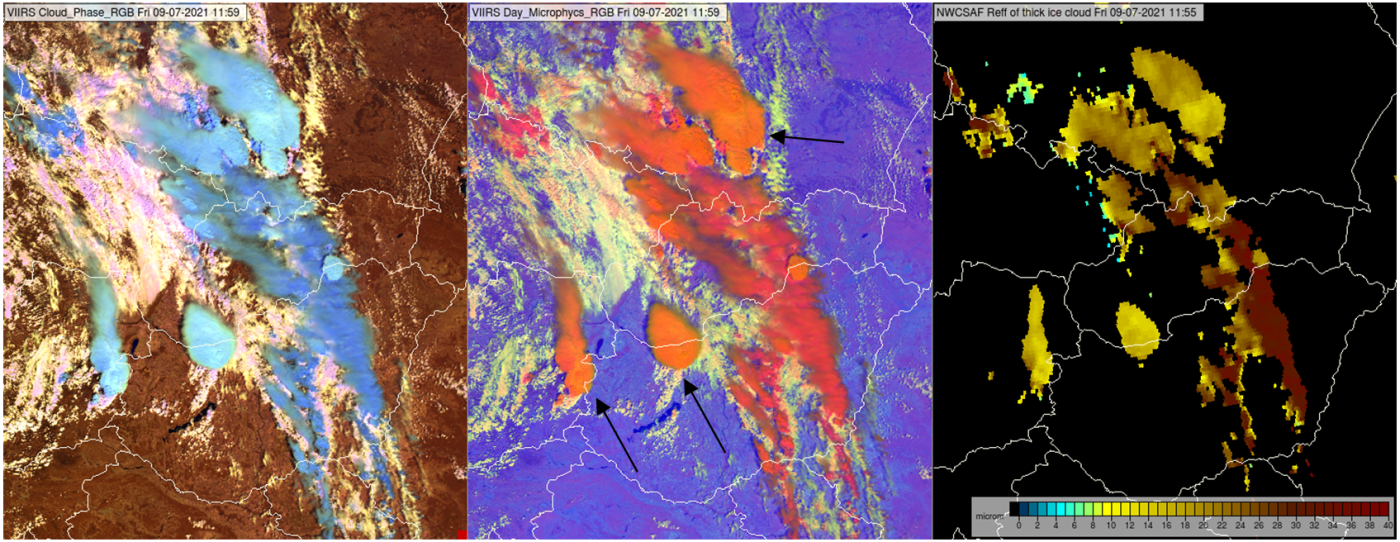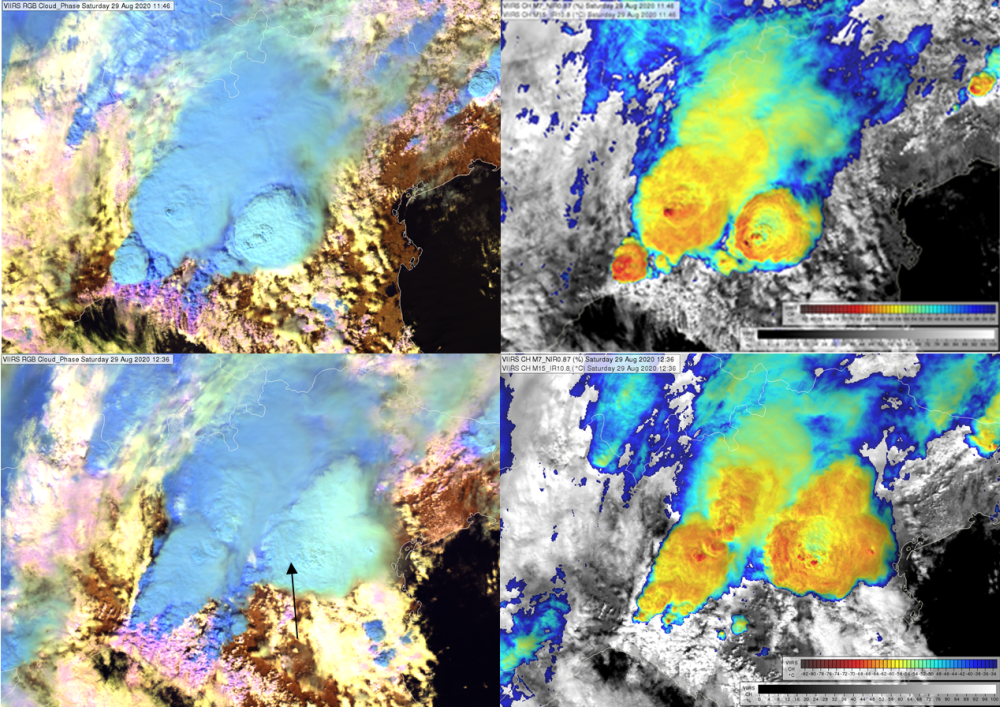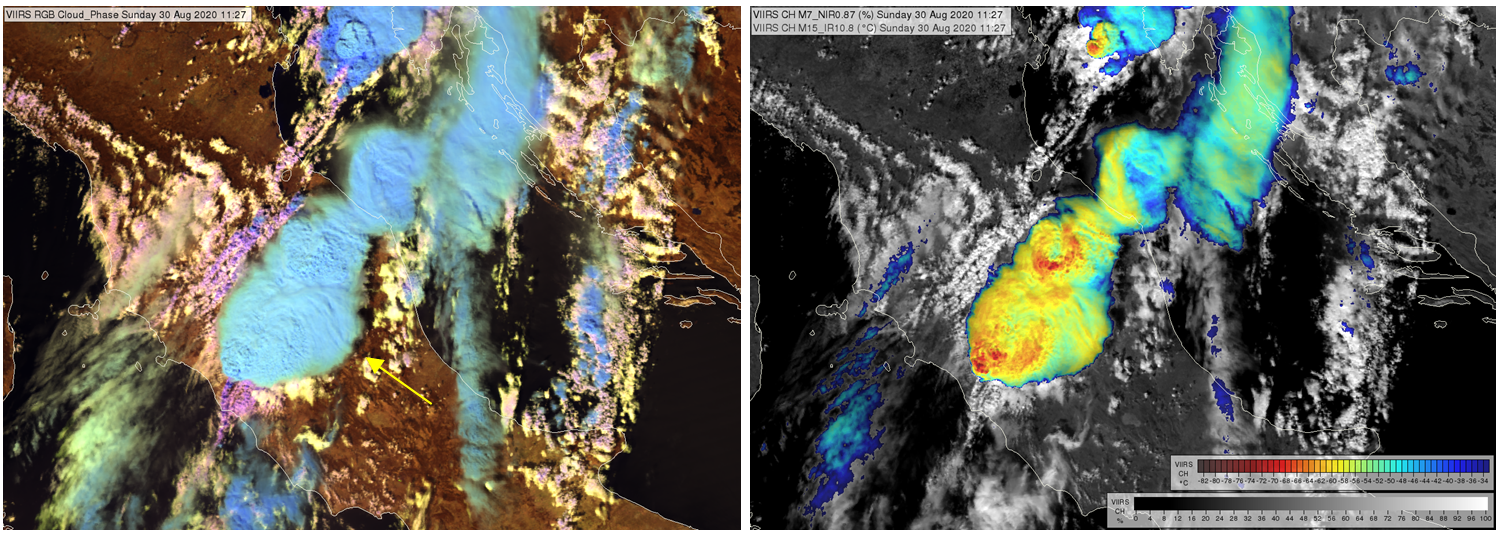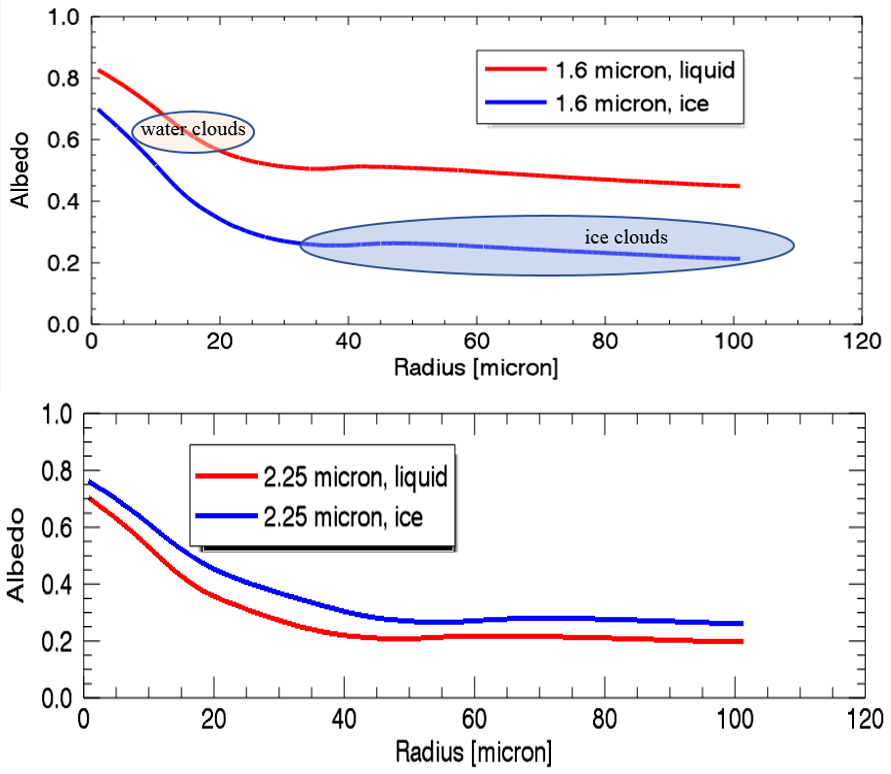Thick ice clouds
Deep convective clouds with strong updraft – severe convective clouds – often appear light blue in Cloud Phase RGB. The reason is that they typically have small ice crystals on their top, and thick ice clouds covered by small ice crystals appear light blue in Cloud Phase RGB.
In most of the cases thick ice clouds are covered by large ice crystals (appearing medium blue in the Cloud Phase RGB). However, there are some exceptions when the cloud top ice crystals are small. One of them is severe convection with strong updraft. The reason is the following. Strong updrafts often bring small ice particles up to the cloud top. Due to the strong updraft the small droplets formed at the cloud base do not have much time to become larger by coagulation before freezing.
The left panels of figures 1, 2 and 3 show Cloud Phase RGB. Several clouds appear blue with different shades.
Fig. 1 shows a part of Central Europe. The middle and right panels show Day Microphysics RGB (created with NIR1.6) and Cloud Effective Radius product. This triple visualisation helps to confirm whether the light blue clouds in Cloud Phase RGB are really covered by small ice crystals.
• Day Microphysics RGB is also sensitive to cloud top microphysics (phase and mean particle size of the cloud top elements). Thick ice clouds covered by large ice crystals appear red, thick ice clouds covered by small ice crystals appear orange in the Day Microphysics RGB.
• The Cloud Effective Radius product is retrieved from SEVIRI data by NWCSAF. To make easier the comparison only the effective radii of mainly thick ice clouds are visualised by masking water and thin ice clouds.
The Day Microphysics RGB and the Cloud Effective Radius product confirm that the light blue clouds in the Cloud Phase RGB are really covered by much smaller ice crystals than the medium blue clouds. The reports in the European Severe Weather Database confirm that the convective cloud systems indicated by arrows caused severe weather during their lifetime (tornado, hail, severe wind).

Fig. 1: Left: VIIRS Cloud Phase and Day Microphysics RGB images (left and middle) for 09 July 2021, 11:59 UTC. NWCSAF Cloud Effective Radius product (right) for 09 July 2021, 11:55 UTC.
Figure 2 shows a thunderstorm system over North Italy in two time steps. The left panels show the Cloud Phase RGB, the right panels the Sandwich product. Cloud Phase RGB and Sandwich product complement each other in convection monitoring. Sandwich product provides info on cloud top temperature and the cloud top features, like cold rings and cold U shapes, overshooting tops, gravity waves, ice plumes. Cloud Phase RGB provide info on cloud top microphysics. An F1 tornado was reported around 13 UTC at the location indicated by the arrow.

Fig. 2: VIIRS Cloud Phase RGB and Sandwich images taken on 29 August 2020, at 11:46 and 12:36 UTC.
Figure 3 shows thunderstorm system over central Italy. The large bright blue cell indicated by the arrow caused F2 tornado around 11 UTC.

Fig. 3: VIIRS Cloud Phase RGB image and Sandwich product taken on 30 August 2020 at 11:27 UTC.
Note that:
• The actual colour shades depend on the sun-viewing geometry as well (solar and satellite directions).
• Not all convective clouds appearing light blue in Cloud Phase RGB are severe storms.
• Small ice crystals may form not only due to intense updraft. Small ice crystals can be as well observed: on the tops of storms with cold (high) cloud base, in high level lee clouds and on the tops of highly polluted thick ice clouds.
• Thick ice clouds covered by large ice crystals appear medium blue in Cloud Phase RGB.
• If the thick ice cloud is covered by thin cirrus it might appear slightly greenish or whitish.
Explanation of the colours of thick ice clouds covered by small ice crystals in the Cloud Phase RGB (see the recipe):
• The blue signal is large, a thick cloud has high reflectivity in visible spectral region and it is almost independent on the cloud top microphysics.
• In case of small cloud top particles, the 1.6 and 2.25 μm reflectivity values increase (compared to the case of large cloud top particles), see the graph below. Highlighting the 0-50 % reflectivity range, the red and green signals became stronger than medium but usually lower than the blue signal. (Additionally, the green signal is usually slightly stronger than the red one as the absorption of ice at 2.25 μm is somewhat weaker than at 1.6 μm).
Therefore, thick ice clouds covered by small ice crystals usually appear light blue. The blue signal is strong, while the red and green signals are above medium.
In case the cloud top particles are extremely small, it can happen that the green or both the green and red signals saturate and may become even stronger than the blue one. In such cases the resulting colour may turn to whitish or light greenish or light yellowish.

Fig. 4: Simulated reflectivity of thick ice and water clouds as function of the effective radius of the cloud top particles at 1.6 μm (up) and 2.25 μm (bottom) wavelengthes. The typical range of the cloud top particle size of water and ice clouds are indicated in the upper graph.
(Source: Ralf Bennartz, University of Wisconsin–Madison).

